
You’ve probably been told your whole life that oral hygiene is important—but when most people think about oral hygiene, it’s brushing their teeth that comes to mind; not flossing. But flossing is just as important as brushing those pearly whites. That said, you might be wondering about which flossing method is better for your teeth: the tried-and-true dental floss method, or a fancy new Waterpik? Both have their own benefits; here’s more from your dentist about what each choice has to offer and which you should consider going with.
Dental Floss
First recommended by a dentist named Levi Spear Parmly in 1819, dental floss has heavily influenced the way we clean our teeth for generations. It’s typically made of nylon and comes in either waxed or unwaxed strands, as well as a variety of different flavors. You can also buy dental picks, which are handy little tools with precut strands of floss attached to a plastic holder. These are usually much easier to handle than traditional floss, and just as effective!
But in general, dental floss is still relatively easy to use and can fully clean every tooth in your mouth. It effectively removes bacteria and food particles from between your teeth and prevents sticky plaque from accumulating and turning into tartar. Though, you might experience a little difficulty trying to floss between teeth that are very close together. Your gumline could also begin bleeding if you aren’t gentle. But dental floss is still completely safe to use and is highly recommended as an integral part of your oral hygiene routine.
The Waterpik
Also called oral irrigators, Waterpik water flossers were invented in the early 1960’s by a dentist and one of his patients, who was actually a hydraulic engineer! They discovered that a pressurized stream of pulsating water could be used to clean between your teeth and under your gumline. Furthermore, if you could control the power and temperature of the water, every patient could find a comfortable setting for flossing their teeth—and thus, the modern Waterpik was born.
Waterpiks make flossing much easier for patients who have braces, crowns, implants, or nonremovable bridgework. They’re also great for patients with arthritis or limited mobility that makes brushing challenging. Not only are Waterpiks also easy to operate, but they provide access to spaces in the mouth that normal floss can’t reach! However, be mindful that Waterpiks cannot completely remove plaque from the surface of your teeth, and they are not a substitute for brushing or visiting your dentist.
Which Is Better for My Teeth?
The bottom line is that either of these methods can be highly effective if you stick with it—when it comes to oral hygiene, consistency is key! Many people prefer using traditional floss, as it gives them full control over the cleaning process. However, others claim that nothing cleans their teeth quite like their Waterpik. Since research shows that both methods are effective and there’s minimal difference in how much plaque they each remove, the choice is ultimately up to you!
Flossing might not always be easy, but it’s certainly always worth it. Talk with your dentist if you have questions about flossing and the available methods; both are sure to contribute to a healthy and beautiful smile.
About the Practice
Dr. Krunal Patel and Dr. Poorvi Gandhi lead the team at NeoSmile Dental Care, and both are proud to provide an elite level of dental care for every patient that they treat. Both doctors have several collective years of experience and expertise in a wide range of fields. Their practice is pleased to offer many available services including preventive, restorative, and cosmetic options. If you have any questions for Dr. Patel or Dr. Gandhi, don’t hesitate to reach out online or by phone at: (215) 643-5220.


